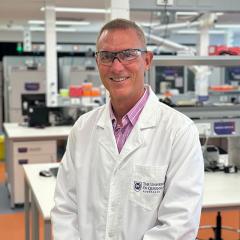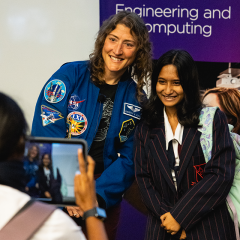Harnessing a rare metal to help produce clean, affordable energy has been rewarded for two University of Queensland research teams.
Teams led by Professor John Zhu and Professor Lianzhou Wang, both from the School of Chemical Engineering, have been nominated for the inaugural Anders Gustaf Ekeberg Tantalum Prize.
The prize, named after the Swedish scientist who discovered the rare tantalum metal in 1802, recognises excellence in published tantalum research.
Professor Zhu’s research, published in Nature Communication, looks at the use of tantalum as an additive, or dopant, for producing electricity in solid oxide fuel cells at lower temperatures than presently available.
Solid oxide fuel cells are an electrochemical device that can convert the chemical energy of fuels such as hydrogen, natural gas or biogas directly into electricity in a highly efficient, low cost way that produces lower emissions than other methods. Commercialisation and wider applications of solid oxide fuel cells are hampered by the high temperatures now needed to produce the electricity.
Professor Zhu’s use of tantalum and niobium – another rare metal – as co-dopants in the cathode of the fuel cell means the cells works efficiently at relatively low temperatures, making the technology attractive for future energy production.
“The properties of rare transition metals such as tantalum open doors which will greatly improve the production of clean and renewable energy,” Professor Zhu said.
Professor Wang’s team has shown a way to create tantalum nitride nanomeshes to boost the performance of hydrogen production for renewable energy generation.
“Tantalum nitride nanomeshes are used as photo-catalysts to produce hydrogen fuel from water,” Professor Wang said.
“Hydrogen can act as a clean energy source to replace fossil fuels.
“By using a different way to create the nanomesh we were able to see a greater than tenfold improvement in solar hydrogen production compared to other methods,” Professor Wang said.
Severe energy loss in photo-catalysts currently results in poor performance for solar hydrogen conversion. The tantalum-based nanomeshes have the unique advantage of losing less energy than other materials, resulting in significantly higher solar hydrogen production performance.
Professor Wang’s research is published in Advanced Energy Materials.
The winner of the prize will be announced in October by the Tantalum-Niobium International Study Centre.
Tantalum facts
- Tantalum has a melting point of 2996° C
- It is used in cutting tools, lenses, capacitors, valves, claddings, computer hard drives, jets engines, and many other applications needing high temperature and corrosion resistant superalloys.
- Australia has the world’s second largest reserves of tantalum.
- Recycling produces about 20 per cent of the world’s tantalum supply
- Most tantalum produced ends up in mobile phones as high-performing capacitors
- It was discovered in 1802 by Swedish scientist Anders Gustaf Ekeberg
- A kilogram of tantalum sells for about $250



